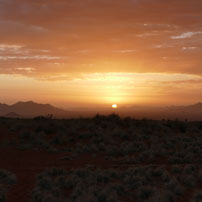 The Kalahari and Namib Deserts are fascinating areas which between them cover a huge swathe of south-west Africa. My trip was beginning in Upington in the northern Cape of South Africa, and would end in Windhoek, capital city of Namibia, and my three main areas of exploration would be the Kgalagadi Transfrontier Park (spanning both Botswana and South Africa), the Fish River Canyon in deep southern Namibia and the Namib Desert dunes around Sossusvlei in south-west Namibia.
The Kalahari and Namib Deserts are fascinating areas which between them cover a huge swathe of south-west Africa. My trip was beginning in Upington in the northern Cape of South Africa, and would end in Windhoek, capital city of Namibia, and my three main areas of exploration would be the Kgalagadi Transfrontier Park (spanning both Botswana and South Africa), the Fish River Canyon in deep southern Namibia and the Namib Desert dunes around Sossusvlei in south-west Namibia.
I was being accompanied by an old travelling friend ‘Noj’ (Jon backwards, a childhood gimmick that ‘stuck’) who was helping me with the several thousand kms we were driving on remote gravel roads and acting as a ‘model’ as I filmed an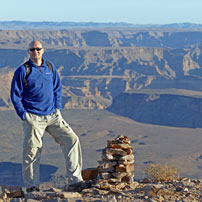 d photographed my way around the desert (though with him being 6ft4 and bald with a gambling gait and bright blue fleece I have to admit I kept an eye out for other ‘models’). We have travelled a huge amount together to remote places so I think he was ready for the gruelling schedule ahead…………though I did recall at one point before departure that he wasn’t great with very high temperatures and never particularly liked ‘sand’. Oops.
d photographed my way around the desert (though with him being 6ft4 and bald with a gambling gait and bright blue fleece I have to admit I kept an eye out for other ‘models’). We have travelled a huge amount together to remote places so I think he was ready for the gruelling schedule ahead…………though I did recall at one point before departure that he wasn’t great with very high temperatures and never particularly liked ‘sand’. Oops.
I love visiting new territory and it has taken a few years to find the right time to visit the Kgalagadi Transfrontier Park which spans both south-west Botswana and a slice of north-west South Africa. In Upington we had collected our fantastic hire car (Toyota Fortuner) and driven around 250kms through vast Kalahari farms and quiet outposts to reach Twee Rivieren (Two Rivers), the largest of the 3 principal National Parks rest camps in the park. It was hot (pushing 40 degrees) and bright, the November rains not yet arrived, but the parks offices were clean, cool and well-staffed – a far cry from my early memories of African ‘outposts’.
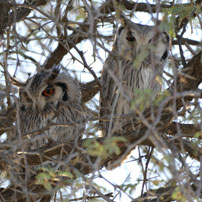 Twee Rivieren (which is at the southern end of the park) is located near the confluence of the two local river valleys which cut through the desert dunes. The Nossob Valley runs roughly north to south and forms the border between Botswana and South Africa. As the road along the valley swaps from one country to the other regularly, the valley is treated as ‘international’ territory and you can explore from either ‘country’. We ‘entered’ Botswana at Twee Rivieren and drove through to the lovely Rooiputs Lodge where we spent two nights. We enjoyed a guided day trip north along the valley to Nossob and back – it was a very long day through spectacular scenery and we saw plenty of game, including two separate lion sightings (the first of which visited us early morning in Rooiputs Camp, one of the lions drinking from the swimming pool!), several wild cats, meerkats, porcupine, yellow mongoose, many black-backed jackals, kudu, oryx, springbok, wildebeest and lots of pale chanting goshawks, tawny eagles, lanner falcons and my favourite sighting of all – two white-faced owls perched in a camelthorn tree.
Twee Rivieren (which is at the southern end of the park) is located near the confluence of the two local river valleys which cut through the desert dunes. The Nossob Valley runs roughly north to south and forms the border between Botswana and South Africa. As the road along the valley swaps from one country to the other regularly, the valley is treated as ‘international’ territory and you can explore from either ‘country’. We ‘entered’ Botswana at Twee Rivieren and drove through to the lovely Rooiputs Lodge where we spent two nights. We enjoyed a guided day trip north along the valley to Nossob and back – it was a very long day through spectacular scenery and we saw plenty of game, including two separate lion sightings (the first of which visited us early morning in Rooiputs Camp, one of the lions drinking from the swimming pool!), several wild cats, meerkats, porcupine, yellow mongoose, many black-backed jackals, kudu, oryx, springbok, wildebeest and lots of pale chanting goshawks, tawny eagles, lanner falcons and my favourite sighting of all – two white-faced owls perched in a camelthorn tree.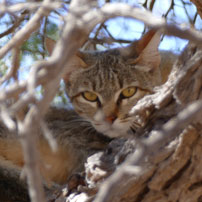
Departing Rooiputs we re-entered South Africa and spent two nights in the Auob Valley which runs north-west to south-east through the park. We drove a spectacular ‘dune road’ between the Nossob and Auob valleys which really allows you to see the extensive dune ecosystem away from the rugged dry river courses. One night was spent at !Xaus Lodge, a community owned lodge in the remote south-west section of the park. Meeting at a picnic site in the Auob Valley we were transferred over 91 sand dunes (apparently, I didn’t count) to reach the lodge which is perched on a sand dune overlooking a vast pan. It is a stunning location and feels completely removed from the rest of the park (and the world, for that matter). A private network of sandy tracks around the local area allows for afternoon game drives and extensive night drives which are productive. We enjoyed a pleasant and very 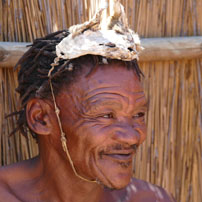 informative morning desert walk, and visited a ‘mock up’ bushman village – the bushman no longer live by traditional methods so the experience is more educational than authentic. On the way out from the lodge we encountered 4 cheetah resting in the shade, a fantastic sighting considering the vast space they roam. Our last night in Kgalagadi was spent at Mata Mata rest camp on the border with Namibia, where there was generally a bit less game around but we enjoyed a night drive with excellent sightings of bat-eared fox, African wild cat and Cape fox.
informative morning desert walk, and visited a ‘mock up’ bushman village – the bushman no longer live by traditional methods so the experience is more educational than authentic. On the way out from the lodge we encountered 4 cheetah resting in the shade, a fantastic sighting considering the vast space they roam. Our last night in Kgalagadi was spent at Mata Mata rest camp on the border with Namibia, where there was generally a bit less game around but we enjoyed a night drive with excellent sightings of bat-eared fox, African wild cat and Cape fox.
From Mata Mata we crossed the quietly efficient border post into Namibia and drove south-west to Keetmanshoop. The first half of the journey was through red sand dunes, typical Kalahari, and we even stopped twice to watch meerkats foraging along the side of the road. So much for meerkats being hard to find in the wild! After a lunch stop and re-fuelling in Keetmanshoop we headed south-west into rugged territory to r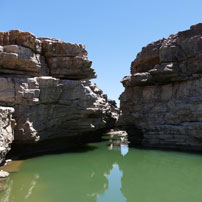 each Fish River Lodge on the western side of the spectacular Fish River Canyon. The views from the lodge were amazing and the lodge itself very comfortable, and we took a self-guided walk along the rocky headland near the lodge for views of the canyon (in the middle distance) and the sunset. It felt very wild, harsh and scenic, with interesting kokerboom (or ‘quiver trees’) dotting the rocky landscape. The following morning we joined a group tour down into the canyon which took us through amazing scenery to the very foot of the canyon. We walked in parts, mainly where staying on the vehicle was uncomfortable with all the ‘bouncing’, and we swam in a gorgeous rock pool which is supported by an upwelling (meaning fresh, croc-free water). After lunch in the shade of one of the very few ‘shepherd trees’ we encountered, we bumped back to the lodge. It was a very exclusive experience with not another person or vehicle in sight.
each Fish River Lodge on the western side of the spectacular Fish River Canyon. The views from the lodge were amazing and the lodge itself very comfortable, and we took a self-guided walk along the rocky headland near the lodge for views of the canyon (in the middle distance) and the sunset. It felt very wild, harsh and scenic, with interesting kokerboom (or ‘quiver trees’) dotting the rocky landscape. The following morning we joined a group tour down into the canyon which took us through amazing scenery to the very foot of the canyon. We walked in parts, mainly where staying on the vehicle was uncomfortable with all the ‘bouncing’, and we swam in a gorgeous rock pool which is supported by an upwelling (meaning fresh, croc-free water). After lunch in the shade of one of the very few ‘shepherd trees’ we encountered, we bumped back to the lodge. It was a very exclusive experience with not another person or vehicle in sight.
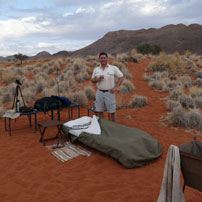 After an overnight at Klein Aus Vista where you can see the ‘wild horses’ of the Namib, we headed northwards into the Namib proper. Our first stop was the wonderful Tok Tokkie walking trail – a two night guided walk through the desert which includes sleeping out under the stars. The walking was not too hard or fast, though some of the sand dunes were tough going and the heat was intense at this time of year. We stopped often to discuss the ecosystem and look at tracks in the sand. On the morning of the full day we climbed a moderately difficult rocky pass to cross a mountain ridge and descend across the plains on the far side – the views were fantastic. But the real highlight of the trail are the sleep outs – I have rarely had the opportunity to connect so obviously with nature. The camps are comfortable because they are not entirely mobile – bush toilets and showers wit
After an overnight at Klein Aus Vista where you can see the ‘wild horses’ of the Namib, we headed northwards into the Namib proper. Our first stop was the wonderful Tok Tokkie walking trail – a two night guided walk through the desert which includes sleeping out under the stars. The walking was not too hard or fast, though some of the sand dunes were tough going and the heat was intense at this time of year. We stopped often to discuss the ecosystem and look at tracks in the sand. On the morning of the full day we climbed a moderately difficult rocky pass to cross a mountain ridge and descend across the plains on the far side – the views were fantastic. But the real highlight of the trail are the sleep outs – I have rarely had the opportunity to connect so obviously with nature. The camps are comfortable because they are not entirely mobile – bush toilets and showers wit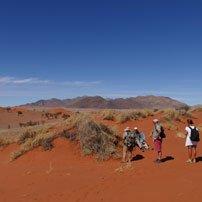 h incredible views are permanent features and there is a small bar, kitchen area and dining table set up in in each camp. But your room is literally a camp bed in sand dunes, probably facing the most gorgeous sunrise, which you are woken for the next morning. A really amazing experience that is not to be missed! To watch my short film on the trail, please click here.
h incredible views are permanent features and there is a small bar, kitchen area and dining table set up in in each camp. But your room is literally a camp bed in sand dunes, probably facing the most gorgeous sunrise, which you are woken for the next morning. A really amazing experience that is not to be missed! To watch my short film on the trail, please click here.
To end the trip we spent a couple of nights near Sossusvlei where you can witness, on foot and by helicopter, the highest sand dunes in the world. The scale and beauty of the dunes is quiet incredible and I particularly enjoyed sunrise from a dune ridge leading to ‘Big Daddy’ overlooking the iconic Dead Vlei. The 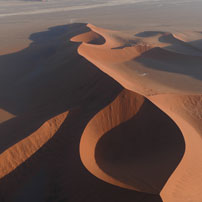 Namib Desert is apparently the oldest desert in the world, but this seems to go against common sense as the dunes appear so ‘fresh’. They are like a stormy sea of sand, stretching 60 miles inland from the Atlantic coast, a re-location of eroded rock particles from the mountains of South Africa transported to the ocean by the Orange River over millennia. The tallest dune is 397 metres high – quite spectacular! Our helicopter trip was fabulous, we had ‘open doors’ which added to the experience (and helped with photography and filming) and the views were incredible. After the high dunes we flew over an eerie wilderness covered in ‘fairy circles’ (the unexplained roughly round bare patches in the desert grassland) and I especially enjoyed seeing oryx standing on a dune beneath us – without doubt the iconic
Namib Desert is apparently the oldest desert in the world, but this seems to go against common sense as the dunes appear so ‘fresh’. They are like a stormy sea of sand, stretching 60 miles inland from the Atlantic coast, a re-location of eroded rock particles from the mountains of South Africa transported to the ocean by the Orange River over millennia. The tallest dune is 397 metres high – quite spectacular! Our helicopter trip was fabulous, we had ‘open doors’ which added to the experience (and helped with photography and filming) and the views were incredible. After the high dunes we flew over an eerie wilderness covered in ‘fairy circles’ (the unexplained roughly round bare patches in the desert grassland) and I especially enjoyed seeing oryx standing on a dune beneath us – without doubt the iconic 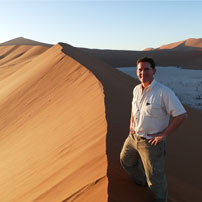 mammal of the Namib Desert. It was probably 15 years since I had last climbed the dunes and flown over them at close range, but it felt as exciting and new as it did the first time. What a place! To view my short film on the Namib Dunes, please click here.
mammal of the Namib Desert. It was probably 15 years since I had last climbed the dunes and flown over them at close range, but it felt as exciting and new as it did the first time. What a place! To view my short film on the Namib Dunes, please click here.
